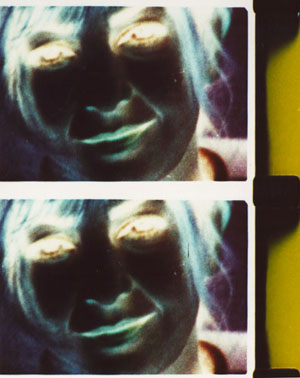
Dóra Maurer
Hand-Made Fractal
Painting series, 1988-95
 | "If we play each pattern very slowly, or hear them this way while we read along in the score, okay, these are very simple factors, but by multiplication they will become superior patterns, or I should say, hyper-patterns. This is exactly what takes place in fractal geometry." (George Ligeti, in: "Steirischer Herbst" p. 13. Quoted by J. Claus: Electronisches Gestalten in Kunstdesign, rororo 1991.) |
If we look at art as a complex system of learning, we cannot avoid employing such methods as enlargement, deceleration, separation of certain segments, the repetition of these segments, classification, or logical and calculated investigation. The accentuation and enlargement over the years of various aspects of my earlier Displacements diagrams were based on this curious, orientative observation and the fortifying deceleration of elusive things, as were my films, which discussed elemental occurrences. 
The picture series entitled "Hand-Made Fractal" was based on a small part of the 46th step in the Displacement Series. At every step, it expands tenfold in a way that only a fragment of the selected diagram enlarges further. The eight-coloured, 3 mm wide lines (which cover the surfaces and thus mark the constellations), as constituents, do not become thicker, but multiply. As a result, the enlargement of the diagram creates new patterns in each picture, but the feeling of enlargement, which is commonly present during a projection, does not occur. Retardation (Inter-Images 1) 16 mm színes film, 1989
"Retardation" (Inter-Images 1) is a five-minute-long film; the expansion of the gradual 90-degree rotation of a female head, on a one-second-long film (25 frames). Each frame of the film contains one-twenty-fifth of the 1/25 movement phase: through one tiny opening of a square-ruled structure we can see every detail of the head. One sound of the entire scale is rendered in every little detail. The 25 details are projected in cycles repeated ten times. The movement which is hidden and detained this way gives the feeling of a more lavish tangibility.  Anti-zoetrope (Inter-Images 2) 16 mm színes film, 1989
The film etude "Anti-zoetrope" (Inter-Images 3) changes the vocation of the zoetrope, that technically primitive apparatus, into its opposite. By large movements it generates a static picture: the camera rotates for three minutes around the perimeter of a boxing match which takes place in a space surrounded by lined-up screens. It sees the event through the gaps between the screens. The faster it moves around the ring, the less it records of any given movement: we see blurs and static pictures.
Back to Current Coordinates |
|